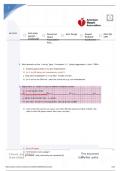Summary
Summary Edexcel A-level Business Theme 2: Managing Business activities
- Institution
- PEARSON (PEARSON)
Pearson Edexcel A-level Business studies notes that cover the whole of Theme 2 (Managing business activities) and are structured using the Edexcel specification.
[Show more]












